Hidden in plain sight in some UK towns and cities are just a few survivors from a short lived postal innovation. Three Points of the Compass takes a dive in to their history and shares how you might find one.
Anyone walking across, living in or visiting the UK will frequently encounter that most prominent of street furniture, the brightly painted red post box. Glancing at it, you might notice that a particular box has a different monarch’s cipher shown on it, or that it is different size. You may even notice that one has different features to the norm. Beneath that thin veneer of red paint there are many stories of development, trial, error and success to be discovered. Here is a brief exploration of just one aspect of that hidden history. The short lived blue airmail boxes of the 1930s.
“So far as the handling of air mails is concerned, the original scheme appears to have been modified in a manner well calculated to produce efficient and economical working, with due regard to the requirements of the future”
D.O. Lumley, Principal, Secretary’s Office, January 1936
The prim statement by senior postal official Lumley mostly disguises a quiet satisfaction. The British Post Office had been pushing the potential for air transport of mail, and beyond the administrative nightmare of logistics and cost, had not been afraid to demonstrate a degree of innovation and flair during this time of change.
The public had the facility for sending urgent letters by air to certain overseas countries on payment of a special airmail fee. This was in addition to the ordinary rate of postage that would have covered overland travel to Europe and beyond. A problem being experienced in the Foreign Section of the British Post Office in the late 1920s was that Air Mail was being mixed with ordinary correspondence and was frequently being delayed as a result. It was proposed in 1929 that a small number of blue painted pillar boxes be placed in prominent positions in London. These would be dedicated to mail bearing the additional fees while the blue colour would also draw attention to the additional facility.
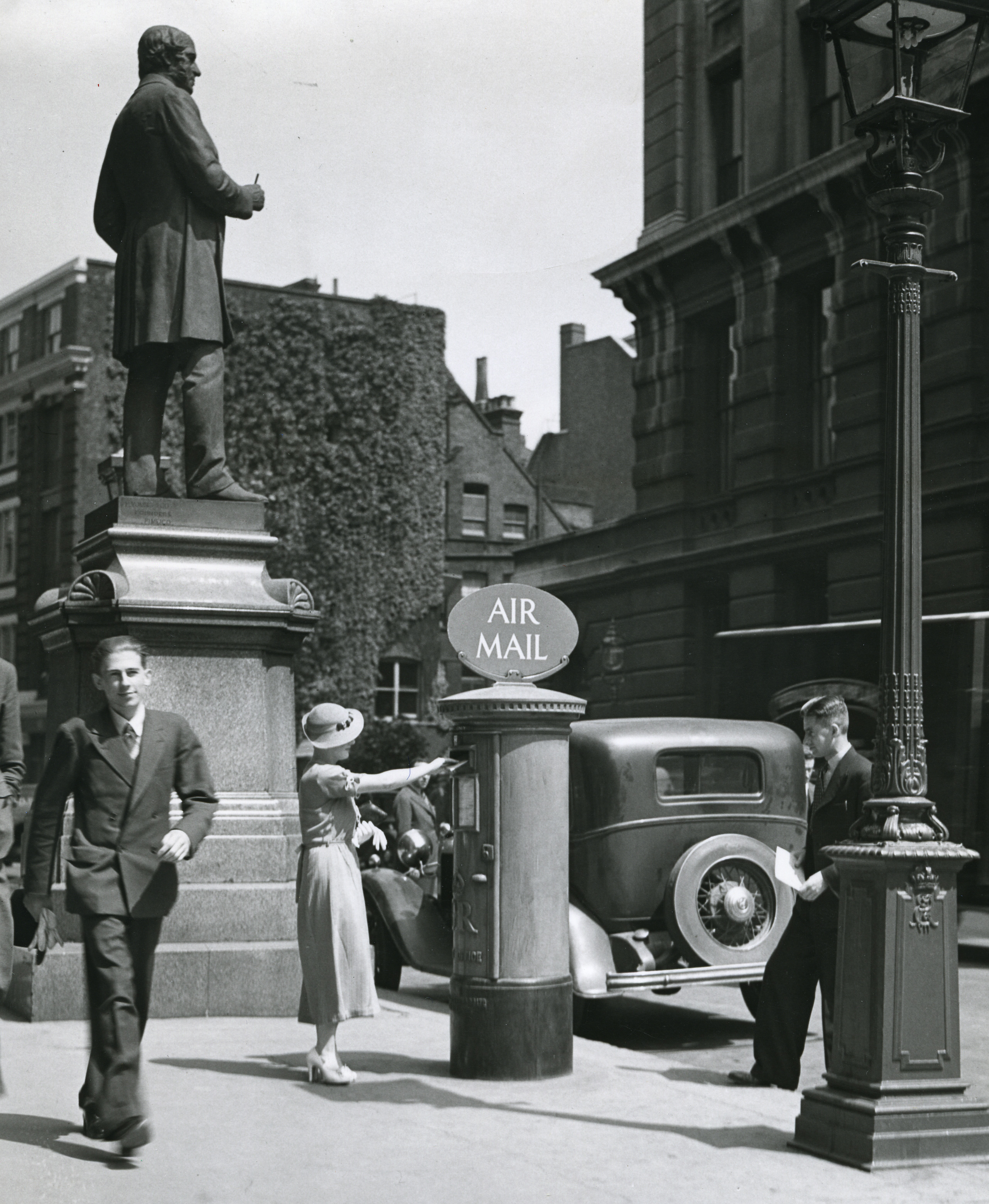
Despite a long association with the colour red for post boxes, it was blue that had become the colour associated with airmail and this was the colour felt most suitable for the new boxes. It also set them aside from the standard boxes for normal correspondence. The exact colour was based on blue airmail etiquettes. These labels were affixed to letters to indicate that they were to be sent by airmail. At first, the pillar boxes themselves were not specially designed or materially altered- ‘”the simplest type of single-apertured pillar box is proposed’“. Carron Co. of Falkirk was a contracted supplier of pillar-boxes to the Post Office and under their contract, fourteen standard ‘B’ type pillar-boxes were set aside for the new service. The new boxes were startlingly attractive, particularly to a public possibly now blasé to the ordinary red British post box. The locations for the first 14 airmail boxes are shown below.
Airmail boxes in Charles Street and Parliament Street were the last to come into service in this group due to difficulties in obtaining permission from the authorities for them to be erected. Other problems were experienced at some localities and alternative solutions were sought. Instead of pillar boxes, Charles Street and the Ludgate Circus Branch Office were each provided with a medium size wall box on pedestals.
Once the first fourteen post boxes at fourteen sites in London had been installed the bright blue colour of the boxes immediately caught the attention of media and public alike even if this did not immediately transmit to an increase in correspondence. The first day of use for the new airmail boxes was 23 June 1930 and within a week some 500 letters were being posted in the boxes each day, double this on Indian Air Mail day. Letters posted in the new boxes required an Air Mail etiquette on the envelope, or alternatively could be marked prominently with the words ‘Air Mail’.

The latest time of posting from an Air Mail box at the London Head Office was usually from 1 ½ – 2 hours before the departure of the aeroplane from Croydon. This later posting required special arrangements to be arranged.
In June 1930, a dedicated fleet of blue airmail vans was introduced due to the need for later collections from the airmail post boxes. With a mind to further advertising of the special service, these vans had a prominent ‘Air Mail’ design. The fleet steadily increased in size over the following years with standard red mail vans occasionally supplementing the service.
Post Office Headquarters were soon receiving requests to have special airmail boxes erected in other districts, such requests came from not only district postmasters, but also from air and ship brokers. Even the department store Selfridge & Co. requested a box, stating that they would pay for it’s installation. However, at this point, it was constantly stressed that the service was an experimental one and that any extension of the scheme would have to wait. Internally within the Post Office, there was a little concern at how little correspondence was being received via the new boxes and they aimed to only extend the service to sub-districts outside Central London where airmail postings and business had increased. A further 19 airmail boxes were introduced in London The locations of this second tranche of airmail boxes are included below.
Advertisements were placed in newspapers local to where boxes were situated, detailing the new service. Businesses in London were also treated to an attractive leaflet designed by the artist Theyre Lee-Elliot.
Collection plates became an unforeseen problem. Ordinary post boxes displayed fairly fixed times of collection on expensive to produce enamel collection plates. This was not the case with the airmail boxes. It was recognised that times of collection were likely to alter frequently with such an experimental service. . The Post Office wished to avoid both the cost of preparing potentially short-lived enamel collection plates, but also have the facility to quickly alter the displayed times. Temporary paper notices were employed instead. At first these were fairly small and were pasted over normal collection plates.
It is sometimes stated that the airmail pillars were fitted with dual or double collection plate holders, this is incorrect. A new type of wide landscape collection plate holder was introduced for airmail boxes, wide enough to show the additional necessary information. These holders had a central bar down the middle of the paper notices, mostly to stop people stealing the celluloid strip covering the notices
The Post Office Savings Bank Department were instructed to design and print a paper notice in landscape format- times of collection were shown on the left and the additional combined postage and air fees on the right. These paper notices were changed when weather conditions affected flight times. Other than the plates on the first few converted boxes, enamel collection plates were not used on blue airmail boxes.
“In addition to the posting in ordinary letter-boxes, facilities are provided in London and the larger towns for the special posting of Air Mail letters in Air Mail boxes, which are painted distinctively in bright blue. The boxes, as a rule, have a later time of posting to connect with the outgoing mails than the ordinary boxes, and their popularity is shown by the fact that quite two-thirds of the Air Mail letters in London are posted in the special boxes”
A newly designed oval ‘Air Mail’ sign was also delivered with each box for attaching to the top of the cap following painting. Based on Post Office Direction signs found on top of standard pillar boxes (that pointed the way to the nearest post office), these 18″ wide enamelled signs were blue in colour (deeper than the blue boxes), with the words, in Trajan Roman characters, ‘AIR MAIL’, in white, on each side. They were fixed to iron brackets on the cap of each pillar box.
In the mid 1930, some newspapers were reporting the imminent provision of airmail boxes in their district; such was the case at Liverpool and Cardiff. Postal Headquarters in London began to receive queries from annoyed Postmaster Surveyors, aggrieved to find that they were being kept in the dark as to proposed developments in their districts. The newspaper reports were all incorrect and premature; at least that was the official response from London based postal officials. Quietly however, steps were being taken to extend the scheme beyond London and introduce airmail boxes across the nation.
“Now that the blue air mail boxes in London seem to have caught on, it seems to me we might begin to examine the second part of the project, i.e. their extension to big Provincial Towns.”
Lumley, Principal, Secretary’s Office, 15 July 1930
Again, locations for an extension of blue airmail boxes to the provinces [contemporary phraseology] were selected mostly on the grounds of the volume of airmail correspondence being posted; in September 1930, the first localities for a ‘second wave’ had been selected. In order of the volume of airmail being posted, these were: Manchester, Liverpool, Edinburgh, Glasgow and Birmingham. In addition, Newcastle was later added.
Initially, twelve B type pillars (two for each location) were ordered from the Carron foundry on 10 April 1931. A further four boxes were ordered in June. Boxes were delivered with internal fittings, a lock with six keys and an ‘Air Mail’ sign for the top. Collection notices were now prepared locally, according to the pattern supplied from London as times of collection for each box varied according to local constraints. The Carron foundry was awarded the contract for the supply of all subsequent B size airmail pillar boxes, each box costing seven shillings more than a standard pillar. We will never see one unique aspect of twenty of these; each having a 9″ long base with flange (that went below ground) rather than the standard 18″ (you can see a standard 18″ base in one of the images below). This was due to limited clearance below ground. The airmail boxes also lacked cut-out ‘fluting’ in their base, but this is also hidden below ground so cannot be seen. Airmail pillar boxes supplied to the provinces (and just some of those supplied to London) can often be easily identified today because they had a slight, but unique, casting of the door that is different from standard red-painted B type pillar boxes.
Bristol, Leeds, Bradford and a few other large towns were proposed for a third wave of airmail boxes. Bournemouth and Cheltenham were also proposed as it was felt that many of the residents had ‘close ties with India’. While posting of air mail correspondence in a blue box was not compulsory, as numbers of air mail boxes increased, the percentage of air mail letters being posted slowly also began to rise and further airmail boxes were introduced.
The volume of airmail being posted in 50 of the largest provincial towns was obtained to ascertain the most suitable locations. Their boxes were authorised by September 1933. By late 1933/early 1934 most districts in the UK had been considered for further installations though not everyone shared the enthusiasm of postal officials. The expansion of the blue box scheme was regarded with extreme suspicion by some municipal authorities. The colour was frequently regarded as too garish and the usual concerns with obstruction to the public thoroughfare were often raised. In Chelmsford, the County Council attempted to charge an annual rent of one shilling per box, quoting a precedent of a one shilling annual rent for some telephone kiosks installed on some county roads. The Post Office refused to pay this, stating that pillar-boxes were provided for the public convenience, and that “the Post Office does not in any case pay rent in respect of a letter-box”. The council agreed to waive the rent in this case. Aldershot Town Council also proved resistant to a box being erected near the Head Office. In this case, the Military Authorities welcomed a box being erected at the Stanhope Lines Branch Office. The Council were roundly criticised in the local press for their actions and a second box was subsequently also allocated to the area.
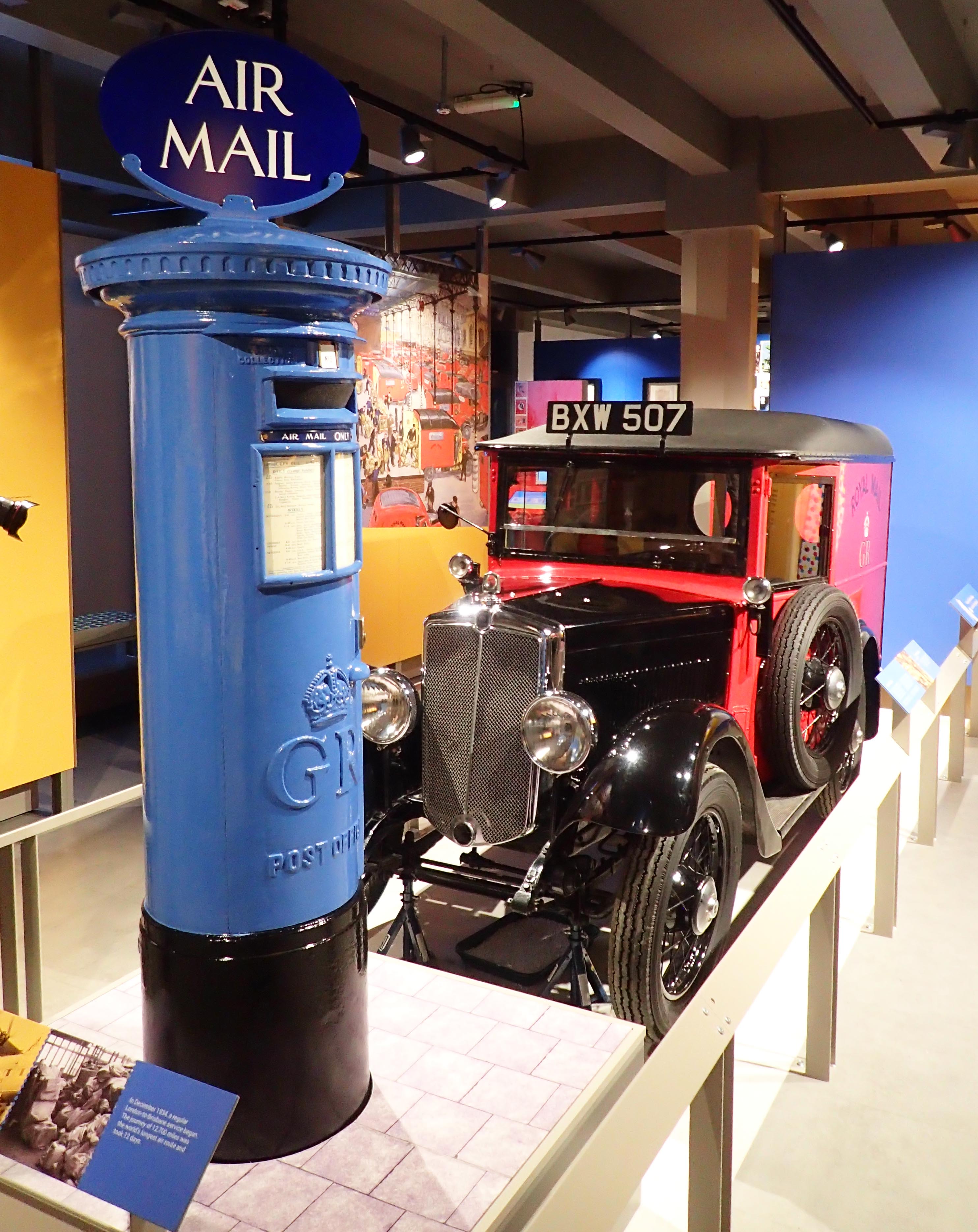
When the blue pillar boxes had been introduced in 1930, around 40 tons of air mail was being despatched from the UK per annum. By 1935, this figure had risen to nearly 200 tons. A further extension to the blue box scheme was also carried out in London in 1935. The intention was to have at least one blue box in every London Sub-District. Once completed, this resulted in a peak in numbers and very few were erected after this.
In 1936, blue painted airmail post boxes in London included wall and window varieties. There was even a box situated at the Olympia Branch Post Office that only opened during exhibition times. Of 174 airmail boxes in the provinces, 11 were wall boxes; the remainder were small B type pillars. Virtually every town that was going to be provided with a blue airmail box had now received one or more. Having succeeded in their roll-out, the Post Office only now began to reflect on the continued effectiveness of providing such an expensive bespoke service.
The introduction of ‘All Up’ airmail to European countries proved to be the undoing of the blue airmail boxes. Under this scheme, first instituted in 1936, letters and postcards were sent by by air at the normal international postage rate of 2 ½ d for the first ounce and a further 1 ½ d for each additional ounce for letters, and 1 ½ d for each postcard. An Empire Air Mail scheme was further introduced in June 1937 for India, Malaya and Australia. Letters were carried at 1 ½ d per half ounce and postcards at 1d. Between 1 100 and 1 200 tons were now carried on this service. This meant that first class mail leaving the UK by air on an All-Up basis reached a total of approximately 2 000 tons per annum. In early 1937 serious consideration was given to abandoning the ‘blue-box’ scheme. None had been ordered for some time and there were occasional surpluses. The end of the short-lived scheme was in sight as their usefulness had become diminished. Mail to any country served by the All-Up scheme had now become ‘ordinary’ correspondence. If it was posted in an airmail box it could potentially be delayed instead of accelerated and most people opted not to pay the special air fee. Figures revealed that the volume of correspondence for which a special air fee was being paid had reached a lower figure than before the blue boxes had been introduced. It was reported that ‘use made of the blue boxes is now negligible’. 40 500 items were posted in one June week in 1935, and reached a peak of 78 000 items per week from 138 airmail boxes in the London Postal Area during the summer of 1937, this had fallen to 23 000 by March 1938. In the provinces, returns were even more disappointing. A survey at Blackburn Head post office revealed that of 71 items posted in their airmail box, only 40 actually bore an Air Mail label, with such small numbers from nine clearances on weekdays and one on Sundays, it is not surprising that this box was removed early, in June 1938.
“In less than a decade, the role of the blue posting box has come and gone”
Press notice, August 1938
The Post Office Circular for 10 August 1938 carried the announcement that ‘instructions will shortly be issued for the removal of the blue boxes’. This was also reported in newspapers on 10 and 11 August and broadcast by the BBC. This was a little late however as the actual physical removal and conversion of some airmail boxes to normal duty had already begun in late 1937/early 1938.
Airmail boxes in Inner London were mostly removed between 5 September and 5 October and those in Outer London mostly 6-7 September 1938. Very few, if any, stayed in place, the aim was to demonstrate a complete removal of the previous service and its replacement by the Empire Airmail ‘all-up’ scheme. The only large-size airmail box, outside Post Office Headquarters, was the last pillar box removed in the London Districts, on 5 October 1938.
Removal of airmail boxes was carefully staged. Air Mail collection notices were replaced with others showing normal collection times that corresponded with red boxes in the vicinity. The special collections by the dedicated fleet of airmail vans ceased and were replaced by collections on foot.

Some boxes in the provinces were removed and converted a little later than those in London- one of those in Bristol was probably the last, in January 1939. The great majority of blue air mail boxes were re-used at later dates, complete with a new coat of red paint. The wide collection plate holders were supposed to be replaced by new frames but a handful had one half of their frame chiselled off so as to provide a narrower ‘standard’ collection plate. An offset single frame can sometimes be an indicator on a surviving box of it’s previous purpose.
It had been stated in 1929 that blue pillar-boxes on the streets would provide two functions: ‘those of propaganda and practical utility’. The blue painted airmail pillars boxes, wall boxes, window boxes and apertures of the 1930s certainly succeeded in this- providing an interesting diversion from the familiar red post-boxes. Eight short years had seen a startling addition to the street furniture portfolio that had also briefly been adapted and extended across the nation. Not only did these advertise the express airmail service as intended, they also reflected an administration that refused to be bound by tradition. Keep an eye open when next passing a GR pillar-box, it may have a story to tell.
How to spot an airmail pillar box:
The first thing to accept is disappointment. Amongst the 118 000+ post boxes in the UK, tens of thousands of them are pillar boxes and of these only some will be from the reign of George V. Of those only a tiny fraction of a percent will be retired airmail boxes. You may never find one, but it is always worth a check. Other than a couple of historical survivors (often recreated and incorrect), there are almost no airmail boxes with either a landscape ‘double’ collection plate or oval sign atop the cap, so the easy identifiers are not present. Some boxes may show where half of the collection plate holder was chiselled off and what is left, is offset to one side. I know of only one ex-airmail pillar box on the streets that has been repainted blue (an incorrect shade) to show it’s historical connection (in Windsor) and that box is an outlier, having a different casting to most surviving provincial airmail boxes. You are more likely to see a standard pillar box painted blue to indicate fans support of certain football teams, a practice frowned on by the authorities. If an old airmail box has survived into a second life as a standard post box it will invariably be painted red and stands mute to an interesting past. However, due to the unique casting of the majority of these boxes, there is a decent indicator for an ex-airmail box.
First you need to identify what you are looking for. Without getting bogged down in minutia, there are three main types of post box in the street. These are pillar, wall and lamp box. You are looking for one of the three main types of pillar box (there are other types not covered here). The three types of pillar are the large capacity cylindrical ‘A’ type, the smaller capacity cylindrical ‘B’ type and the very large oval ‘C’ type, that has two apertures. You can find most of each of these three types with various ciphers. You are looking for a B type pillar box with the GR cipher (King George V) on the door. This will be in plain block lettering, not scrolled like most other ciphers. Be aware that there are a great many of this type of box. If an adult can hug a box and link fingers together, this identifies the smaller B type pillar.

Having found a B type pillar with GR cipher, now look for a handle (door pull) below the key hole and a block surround to the key hole. If present, this brass escutcheon block is normally painted red. They originally had a rotating flap inside to protect the keyhole, none of which are in use today, but the blocks survive. This is not enough in itself. Many GR B types have both handle and escutcheon and almost all are not ex-airmail. What you are looking for is a specific type of door casting where you can easily place an index finger between escutcheon and handle, touching both. There are many examples with a gap that is much smaller, or considerably larger. A finger should fit as shown in the image here. Do be aware, ex-airmail boxes are uncommon and it will take some searching before you find a genuine example. You might never succeed, but good hunting!

The locations of 136 airmail boxes in London and 182 in the provinces, 318 in total, is shown below. There are almost certainly omissions from this list. These were their original locations, though a few may reflect a second, but now incorrect, locality if moved during the blue box scheme. The great majority were re-used as ‘Provincial B Boxes’ pillar boxes at later dates, complete with a new coat of red paint. Any rediscovered ex-airmail boxes today will have been moved from their original position, possibly even to another town or county. Chipped and worn red paint once revealed blue paint beneath and a number of the original airmail boxes were rediscovered in this way however boxes have since been completely stripped and repainted in the intervening years so there is no need to go around scratching paint off boxes! Just a couple of ex-airmail boxes are held in museums and one example is shown below. There were also the 27 blue airmail posting apertures at London Head District and Branch Offices. 20 of these were removed or converted to other purposes. Five of the remaining seven were converted or closed by the Office of Works over the winter of 1938. There was also a special airmail box at Croydon Airport. This was converted to an ordinary post-box on 6 December 1938. It is highly unlikely that any of these apertures have survived, but who knows!
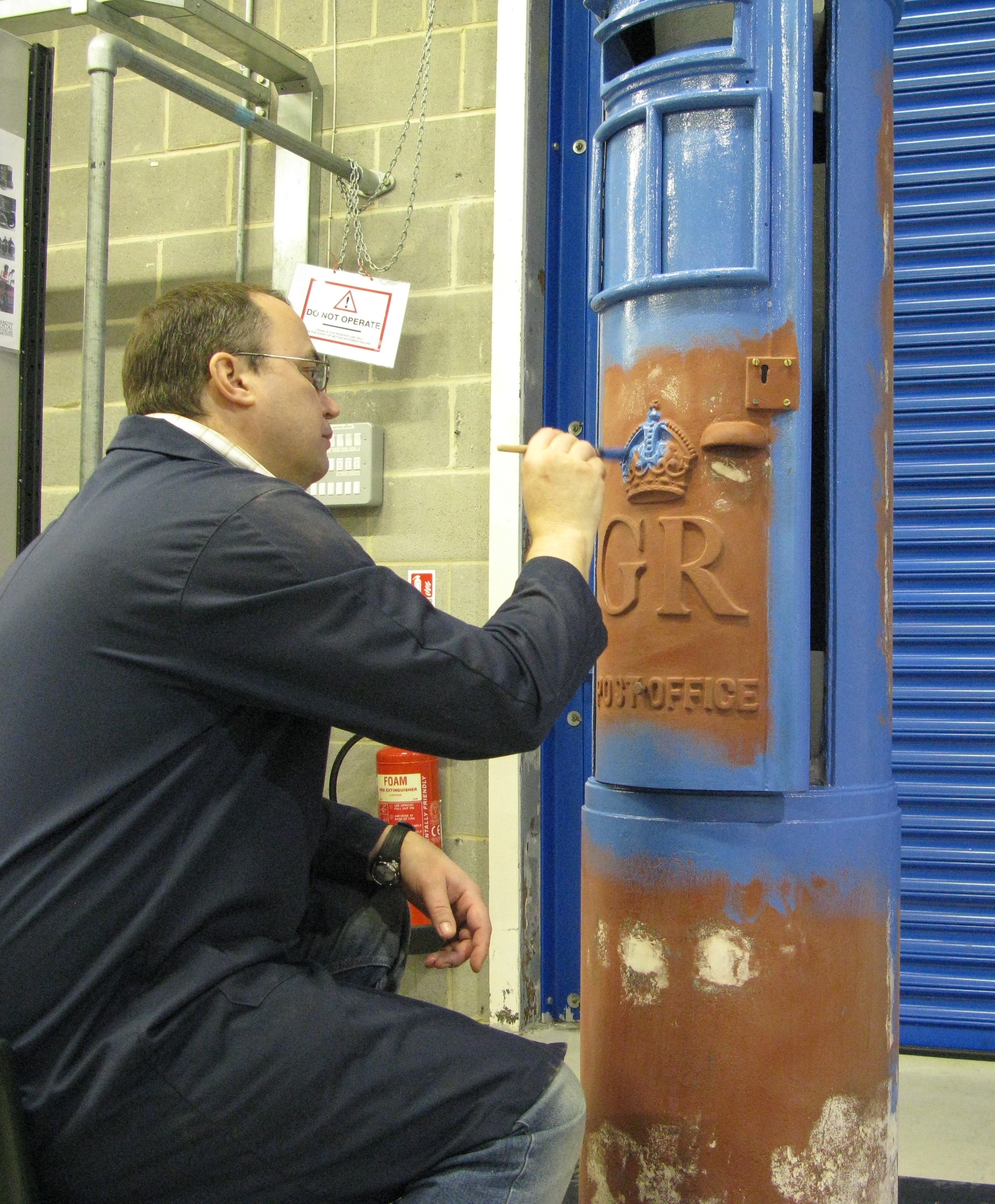
Links to occasional series looking at street furniture in the United Kingdom:
- The ‘Nigerian’ pillar box
- Enlarged aperture wall boxes- the ‘one in every village’ scheme
- The Ludlow post box
- Post boxes on the London LOOP
- Post boxes on the Peddars Way and Norfolk Coast Path
- Sustrans Millennium Mileposts– on the National Cycle Network
- Telephone Kiosks
- Village and Town Signs
Previous locations of the 1930s Airmail post boxes:
AIR 1 | Victoria Station S.W.1 (entrance to forecourt) |
| AIR 2 | Outside Parliament Street Branch post office, S.W.1 |
| AIR 3 | Charles Street, Haymarket S.W.1 (front of Imperial Airways offices) |
| AIR 4 | Piccadilly Circus W.1 (opposite Pavilion Theatre) |
| AIR 5 | Outside Charing Cross Branch post office, W.C.2. |
| AIR 6 | East Strand W.C.2 (near Surrey Street) |
| AIR 7 | Outside Ludgate Circus Branch post office, E.C.4 |
| AIR 8 | Oxford Circus, W.1 (N.E. side) |
| AIR 9 | Outside West Central District post office, High Holborn, W.C.1 |
| AIR 10 | High Holborn W.C.1 (South Side, opposite Staple Inn Buildings) |
| AIR 11 | Moorgate, E.C.2, (opposite Britannic House) |
| AIR 12 | Front of Royal Exchange, E.C.3 |
| AIR 13 | King Edward Street, E.C.1 (outside G.P.O.) Headquarters |
| AIR 14 | Inside Central Telegraph Office (CTO) |
| E.C.1 2 boxes | Kensington, W.8 2 boxes |
| E.C.4 1 box | Chelsea, S.W.3 1 box |
| W.C.2 3 boxes | Earls Court, S.W.5 1 box |
| S.E.1 1 box | South Kensington, S.W.7 1 box |
| N.1 1 box | Hampstead, N.W.3 2 boxes |
| N.W.1 1 box | Golders Green, N.W.11 1 box |
| S.W.1 2 boxes |
| Place | Number of airmail boxes | Notes |
| London | ||
| Wimbledon B.O. S.W.19 | 1 | |
| Tooting B.O. S.W.17 | 1 | |
| Putney B.O. S.W.15 | 1 | |
| Wandsworth B.O. S.W.18 | 1 | |
| Balham B.O. S.W.12 | 1 | |
| Clapham Common B.O. S.W.4 | 1 | |
| Streatham B.O. S.W.16 | 1 | |
| Brixton B.O. S.W.2 | 1 | |
| Sydenham S.E.26 | 1 | |
| Forest Hill B.O. S.E.25 | 1 | |
| East Dulwich S.E.22 | 1 | |
| Eltham High Street S.E.9 | 1 | |
| Woolwich S.E.18 | 1 | |
| Lewisham High Street S.E.13 | 1 | |
| Blackheath Village B.O. S.E.3 | 1 | |
| Charlton B.O. S.E.7 | 1 | |
| Greenwich B.O. S.E.10 | 1 | |
| East Ham B.O. E.6 | 1 | |
| Victoria Docks E.16 | 1 | |
| Plaistow E.13 | 1 | |
| Stratford B.O. E.15 | 1 | |
| Leytonstone B.O. E.11 | 1 | |
| Leyton B.O. E.10 | 1 | |
| Walthamstow B.O. E.17 | 1 | |
| Palmers Green B.O. N.13 | 1 | |
| Wood Green B.O. N.22 | 1 | |
| Tottenham B.O. N.17 | 1 | |
| Finchley Church End B.O. N.3 | 1 | |
| Belsize Park B.O. (Haverstock Hill) N.W.3 | 1 | |
| Golders Green B.O. N.W.11 | 1 | |
| Finchley Road N.W.3 | 1 | |
| East Finchley N.2 | 1 | |
| Hendon N.W.4 | 1 | |
| The Hyde N.W.9 | 1 | |
| Harlesden B.O. N.W.10 | 1 | |
| Cricklewood B.O. N.W.2 | 1 | |
| Ealing Broadway W.5 | 1 | |
| Acton B.O. W.3 | 1 | |
| Chiswick B.O. W.4 | 1 | |
| North Kensington opposite Metropolitan Railway Station | 1 | |
| Shepherds Bush B.O. W.12 | 1 | |
| Hammersmith B.O. W.6 | 1 | |
| Maida Hill W.9 | 1 | |
| Notting Hill Gate B.O. W.11 | 1 | |
| West Kensington W.14 | 1 | |
| Waltham Green B.O. S.W.6 | 1 | |
| Clapham Junction S.W.11 | 1 | |
| Stockwell B.O. S.W.9 | 1 | |
| Camberwell Green B.O. S.E.5 | 1 | |
| Peckham B.O. S.E.15 | 1 | |
| New Cross S.E.14 | 1 | |
| Deptford S.E.8 | 1 | |
| Poplar B.O. E.14 | 1 | |
| Stepney B.O. E.1 | 1 | |
| Bow E.3 | 1 | |
| Eastern District Office E.1 | 1 | |
| Whitechapel B.O. E.1 | 1 | |
| Bethnal Green E.2 | 1 | |
| Hackney B.O. E.8 | 1 | |
| Clapton E.5 | 1 | |
| Stoke Newington B.O. N.16 | 1 | |
| South Tottenham B.O. N.15 | 1 | |
| Hornsey, Crouch End, B.O. N.8 | 1 | |
| Finsbury Park B.O. N.4 | 1 | |
| Highgate N.6 | 1 | |
| Hampstead Heath B.O. N.W.3 | 1 | |
| Hampstead High Street B.O. N.W.3 | 1 | |
| Upper Holloway N.19 | 1 | |
| Holloway B.O. N.7 | 1 | |
| Kilburn B.O. N.W.6 | 1 | |
| St. Johns Wood B.O. N.W.8 | 1 | |
| Kensington High Street B.O. W.8 | 1 | |
| Kensington, Young Street B.O. W.8 | 1 | |
| Lancaster Gate W.2 | 1 | |
| Paddington Spring St. B.O. W.2 | 1 | |
| Paddington Station B.O. W.2 | 1 | |
| Olympia B.O. W14 | 1 | |
| Earls Court B.O. S.W.5 | 1 | |
| Fulham Road B.O. S.W.10 | 1 | |
| South Kensington B.O. S.W.7 | 1 | |
| Kennington S.E.11 | 1 | |
| Walworth S.E.17 | 1 | |
| Rotherhithe S.E.16 | 1 | |
| Elephant and Castle B.O. S.E.1 | 1 | |
| Old Kent Road S.E.1 | 1 | |
| Tooley Street S.E.1 | 1 | |
| Waterloo Station S.E.1 | 1 | |
| Borough High Street, 19A. B.O. S.E.1 | 1 | |
| South Eastern District Office S.E.1 | 1 | |
| Highbury B.O. N.1 | 1 | |
| Islington B.O. N.1 | 1 | |
| Northern District Office N.1 | 1 | |
| Kings Cross Station N.1 | 1 | |
| Euston Road N.W.1 | 1 | |
| North Western District Office N.W.1 | 1 | |
| West District Office W.1 | 1 | |
| Marble Arch B.O. W.1 | 1 | |
| Piccadilly W.1 | 1 | |
| Piccadilly Circus W.1 | 1 | |
| Oxford Circus W.1 | 1 | |
| Orchard Street W.1 | 1 | |
| South West District Office (Howick Place) S.W.1 | 1 | |
| Victoria Station (forecourt) S.W.1 | 1 | |
| Parliament Street B.O. S.W.1 | 1 | Special box constructed by Office of Works |
| Charles Street S.W.1 | 1 | ‘B’ size wall box on pedestal |
| Knightsbridge 55 B.O. S.W.1 | 1 | |
| House of Commons S.W.1 | 1 | |
| New Oxford Street W.C.1 | 1 | |
| High Holborn W.C.1 | 1 | |
| Woburn Place W.C.1 | 1 | |
| West Central District Office W.C.1 | 1 | |
| East Strand B.O. W.C.2 | 1 | |
| Law Courts W.C.2 | 1 | |
| Leicester Square B.O. W.C.2 | 1 | |
| Charing Cross B.O. W.C.2 | 1 | shortened base |
| Cannon Street, 97, B.O. E.C.4 | 1 | |
| Cannon Street, 47, B.O. E.C.4 | 1 | |
| Fleet Street B.O. E.C.4 | 1 | |
| Ludgate Circus B.O. E.C.4 | 1 | ‘B’ size wall box on pedestal |
| Queen Victoria Street B.O. (144) E.C.4 | 1 | |
| Royal Exchange E.C.3 | 1 | |
| Aldgate E.C.3 | 1 | |
| Lombard Street B.O. E.C.3 | 1 | |
| Fenchurch Street B.O. E.C.3 | 1 | |
| Leadenhall St. B.O. E.C.3 | 1 | |
| Throgmorten Ave. B.O. (London Wall) E.C.2 | 1 | |
| Liverpool Street Station E.C.2 | 1 | |
| Threadneedle Street B.O. | 1 | |
| Moorgate B.O., E.C.2 | 1 | |
| Moorgate, Britannic House E.C.2 | 1 | |
| Holborn Circus E.C.1 | 1 | |
| Holborn, Brooke Street E.C.1 | 1 | |
| Head Post Office (King Edward Street) E.C.1 | 1 | Original B box changed to an A type in 1933 |
| Inside Central Telegraph Office E.C.1 | 1 | |
| Mount Pleasant E.C.1 | 1 | |
| Barbican B.O. E.C.1 | 1 | |
| Provinces | ||
| Aberdeen | 1 | |
| Accrington | 1 | |
| Aldershot | 1 | Box was transferred from Swansea |
| Aldershot/ Stanhope Lines | 1 | |
| Ayr | 1 | |
| Barking | 1 | |
| Bath | 1 | |
| Bedford | 1 | |
| Belfast | 1 | A box was made locally and erected in the side wall of the Head Office |
| Bexhill-on-Sea | 1 | |
| Birkenhead | 1 | |
| Birmingham | 6 | |
| Blackburn | 2 | |
| Blackpool | 1 | Aperture/wall box |
| Bognor Regis | 1 | |
| Bolton | 2 | |
| Bournemouth | 2 | |
| Boscombe | 1 | |
| Bradford | 1 | |
| Brighton | 1 | |
| Brighton/Hove | 1 | |
| Bristol | 2 | |
| Bromley | 1 | |
| Cambridge | 1 | |
| Canterbury | 1 | |
| Cardiff | 2 | |
| Carlisle | 1 | |
| Chatham | 1 | |
| Chelmsford | 1 | |
| Cheltenham | 1 | |
| Chippenham | 1 | Re-allocated from Trowbridge in 1935 |
| Colchester | 1 | |
| Coventry | 1 | |
| Croydon | 6 | One of these was specially constructed and was fixed to the wall of the Aerodrome building |
| Derby | 2 | |
| Devonport | 1 | |
| Douglas | 1 | |
| Dover | 1 | |
| Dudley | 1 | |
| Dundee | 1 | |
| Eastbourne | 1 | |
| Edgware | 1 | |
| Edinburgh | 5 | A wooden air mail box was installed the Head Post Office |
| Enfield | 1 | |
| Epson | 1 | |
| Exeter | 1 | Box supplied with shortened base- 1’ 3” removed |
| Falkirk | 1 | |
| Folkestone | 1 | |
| Glasgow | 10 | |
| Gloucester | 1 | |
| Gravesend | 1 | |
| Great Yarmouth | 1 | |
| Greenock | 3 | |
| Grimsby | 1 | |
| Guildford | 1 | |
| Halifax | 1 | |
| Harrow | 2 | |
| Hartlepool | 1 | |
| Hastings | 1 | |
| Hitchen and Letchworth | 1 | |
| Hounslow | 1 | |
| Huddersfield | 2 | |
| Hull | 1 | |
| Ilford | 1 | |
| Ipswich | 1 | |
| Kidderminster | 1 | |
| Kilmarnock | 1 | |
| Kingston-on-Thames | 1 | |
| Leeds | 1 | |
| Leicester | 1 | |
| Leamington Spa | 1 | |
| Letchworth | 1 | |
| Llanelly | 1 | |
| Liverpool | 4 | |
| Londonderry | 1 | |
| Maidenhead | 1 | |
| Maidstone | 1 | |
| Manchester | 8 | Of these: Post box erected in window of Newton Street Post Office. The Office of Works erected a window box for Airmail at the Thomas Street Branch Office in 1934. In 1935, built in window boxes were also erected in: Royal Exchange Branch Office, Hanging Ditch Branch Office, Deansgate Branch Office |
| Middlesborough | 1 | |
| Newcastle-on-Tyne | 1 | Aperture/wall box |
| Newmarket | 1 | |
| Newport, Mon. | 1 | Box supplied with shortened base |
| Northampton | 1 | |
| North Shields | 1 | |
| Norwich | 1 | |
| Nottingham | 2 | |
| Oxford | 1 | One of the three posting apertures in front of the Office was designated ‘Air Mail’ |
| Paisley | 1 | |
| Peterborough | 1 | |
| Plymouth | 2 | |
| Portsmouth | 2 | |
| Preston | 1 | |
| Reading | 1 | |
| Redditch | 1 | |
| Richmond | 1 | |
| Rochester | 1 | |
| Romford | 1 | |
| St. Helens | 1 | |
| Salford | 1 | |
| Salisbury | 1 | |
| Sheffield | 1 | |
| South Shields | 1 | |
| Southall | 1 | |
| Southampton | 1 | Large, bronze fronted box with blue surround. Apertures to this were provided both outside and inside Civic Centre Branch Office |
| Southampton Docks | 1 | |
| Southend-on-Sea | 1 | |
| Southsea | 1 | |
| Staines | 1 | |
| Stirling | 1 | |
| Stockport | 1 | |
| Stourbridge | 1 | |
| Sunderland | 1 | |
| Sutton, Surrey | 1 | |
| Swansea | 2 | |
| Taunton | 1 | |
| Torquay | 1 | |
| Tunbridge Wells | 1 | |
| Wallasey | 1 | |
| Walsall | 1 | |
| Warrington | 1 | |
| Warwick and Leamington | 1 | |
| Watford | 1 | |
| Wembley | 1 | |
| West Bromwich | 1 | |
| West Hartlepool | 1 | |
| Weston-super-Mare | 1 | |
| Weybridge | 1 | |
| Windsor | 1 | |
| Woking | 1 | |
| Wolverhampton | 3 | |
| Worcester | 1 | |
| Worthing | 1 | |
| Yeovil | 1 |
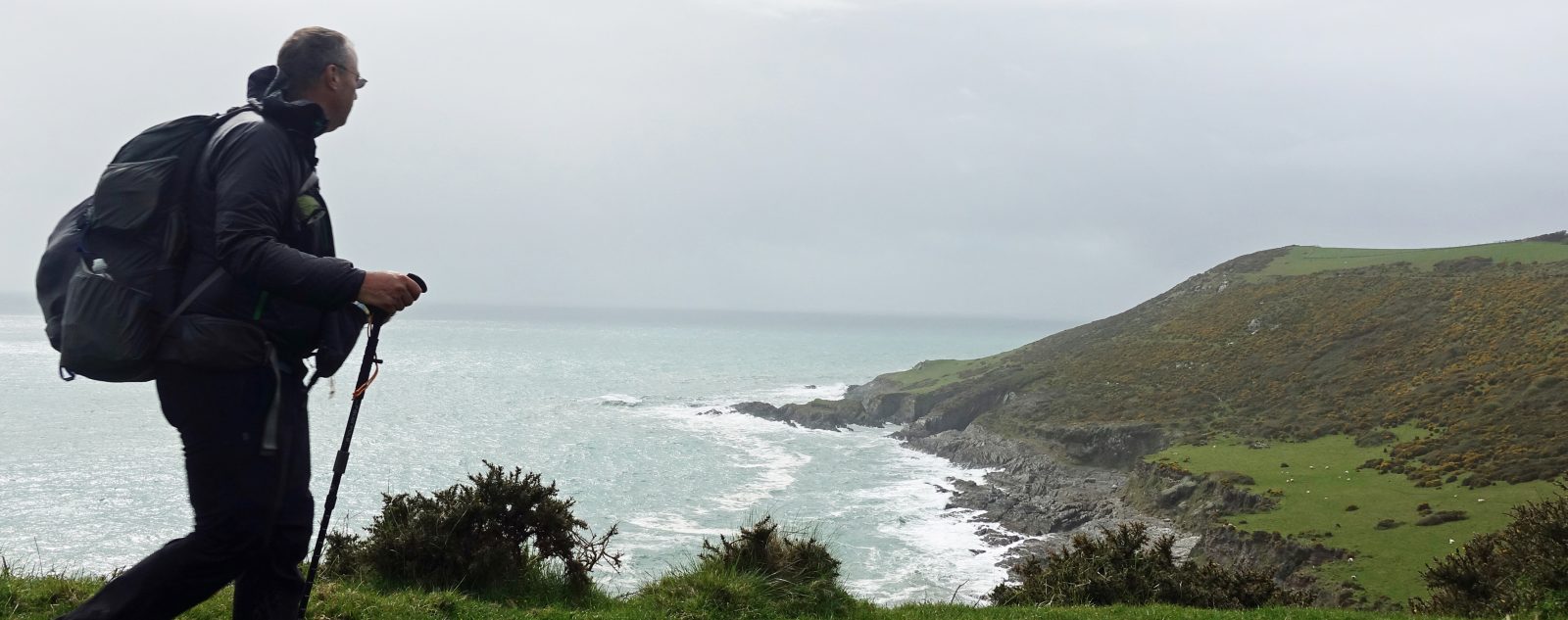
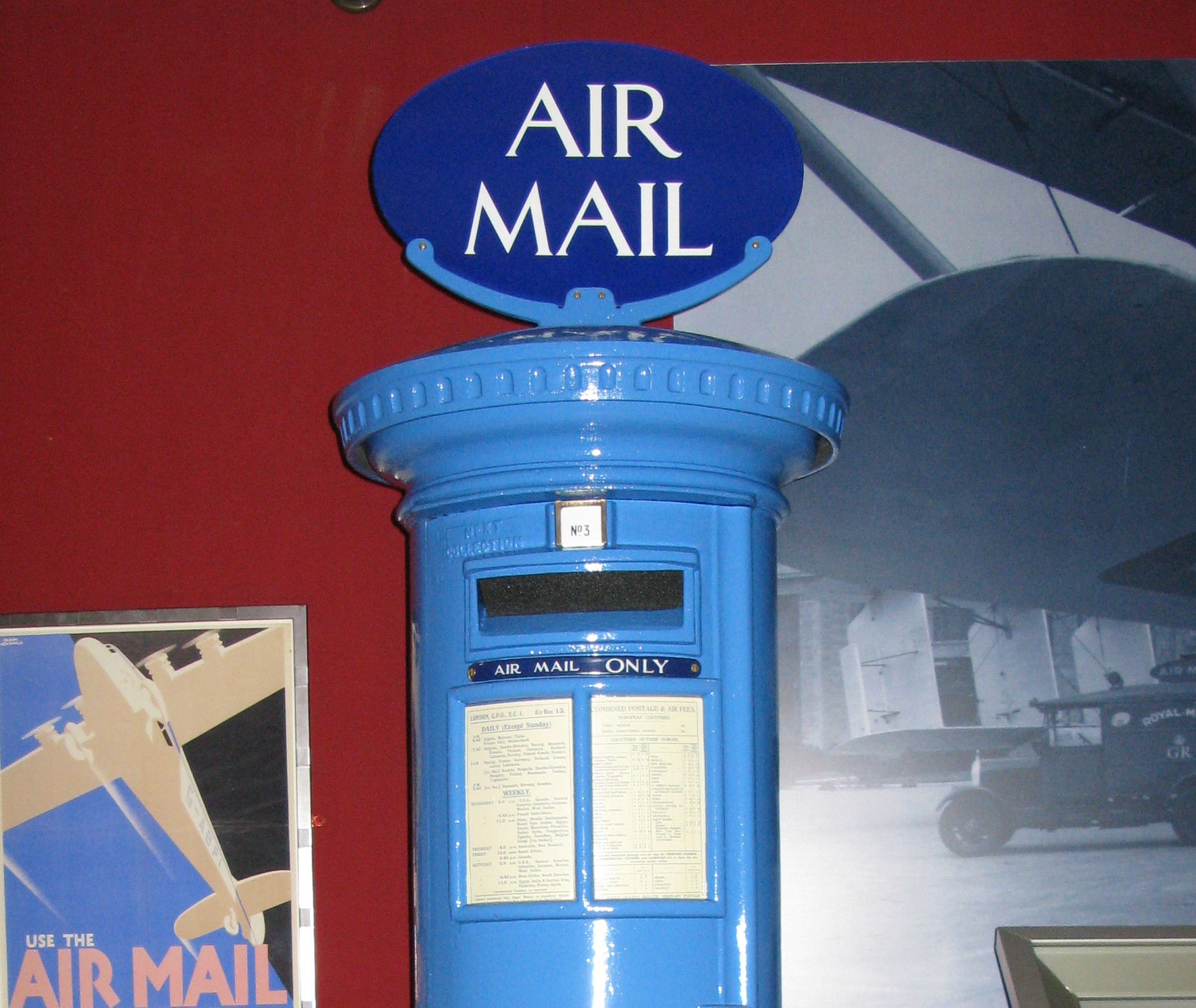
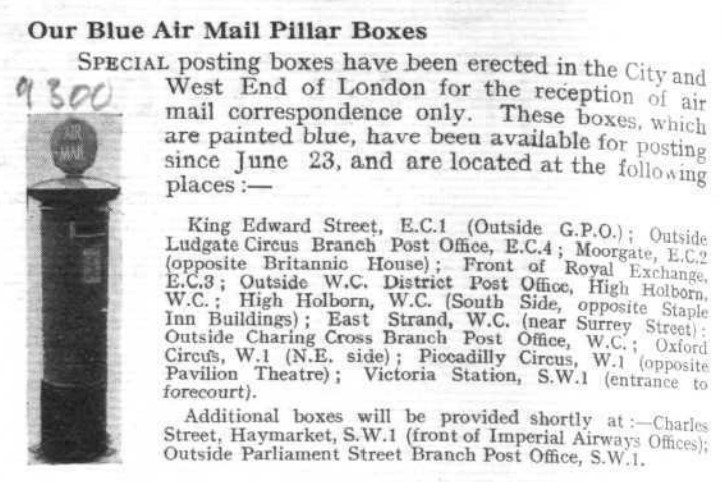

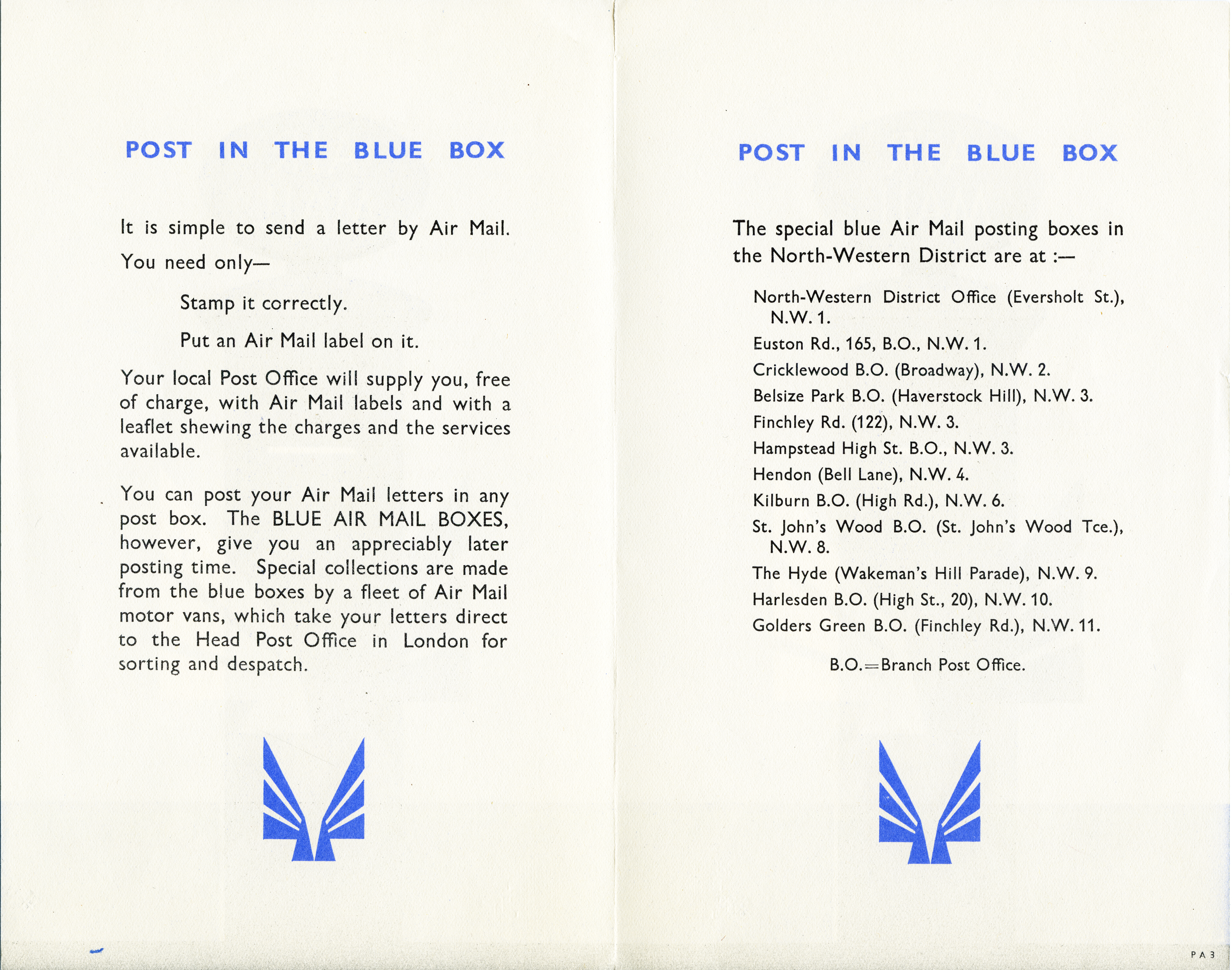
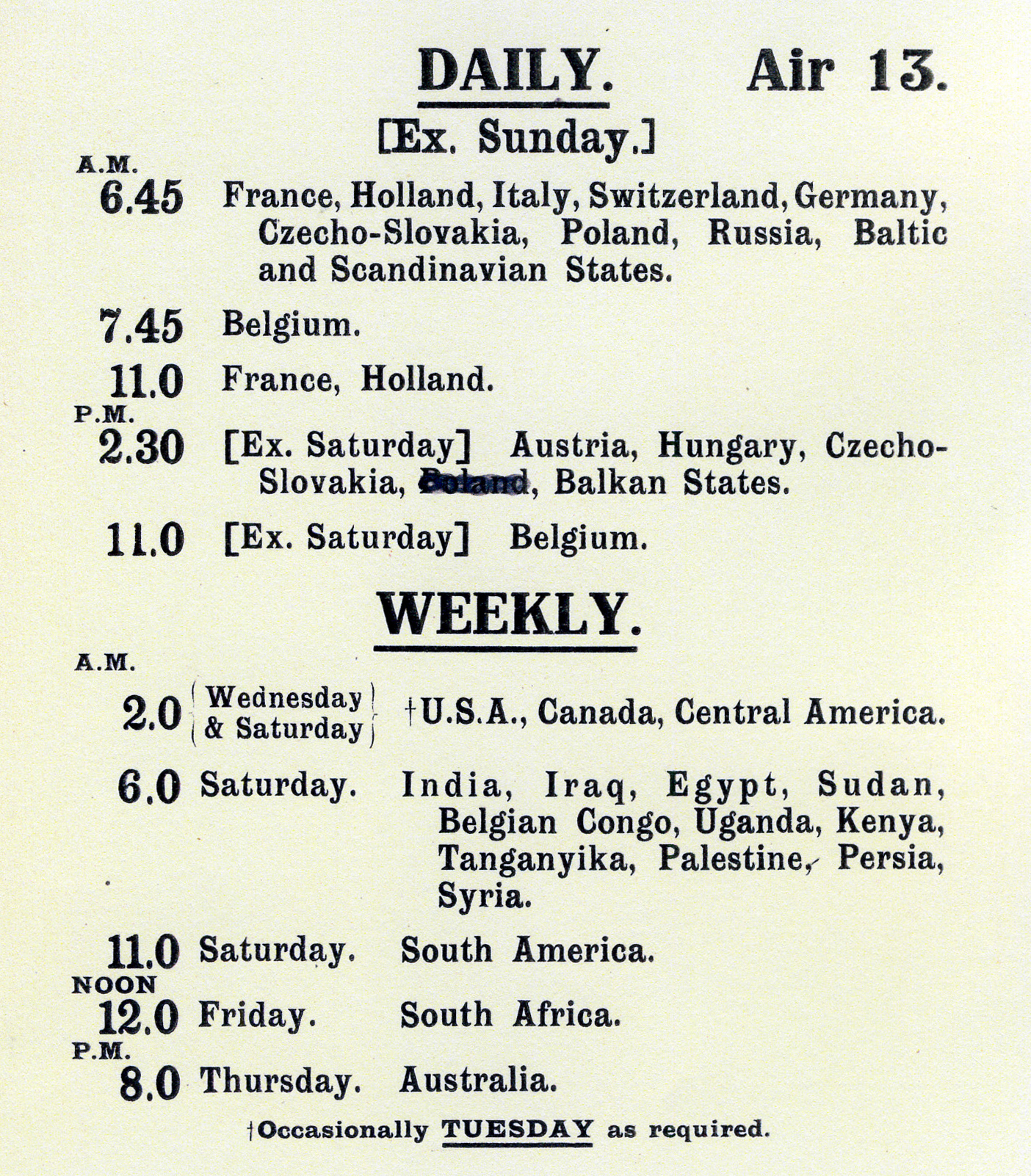
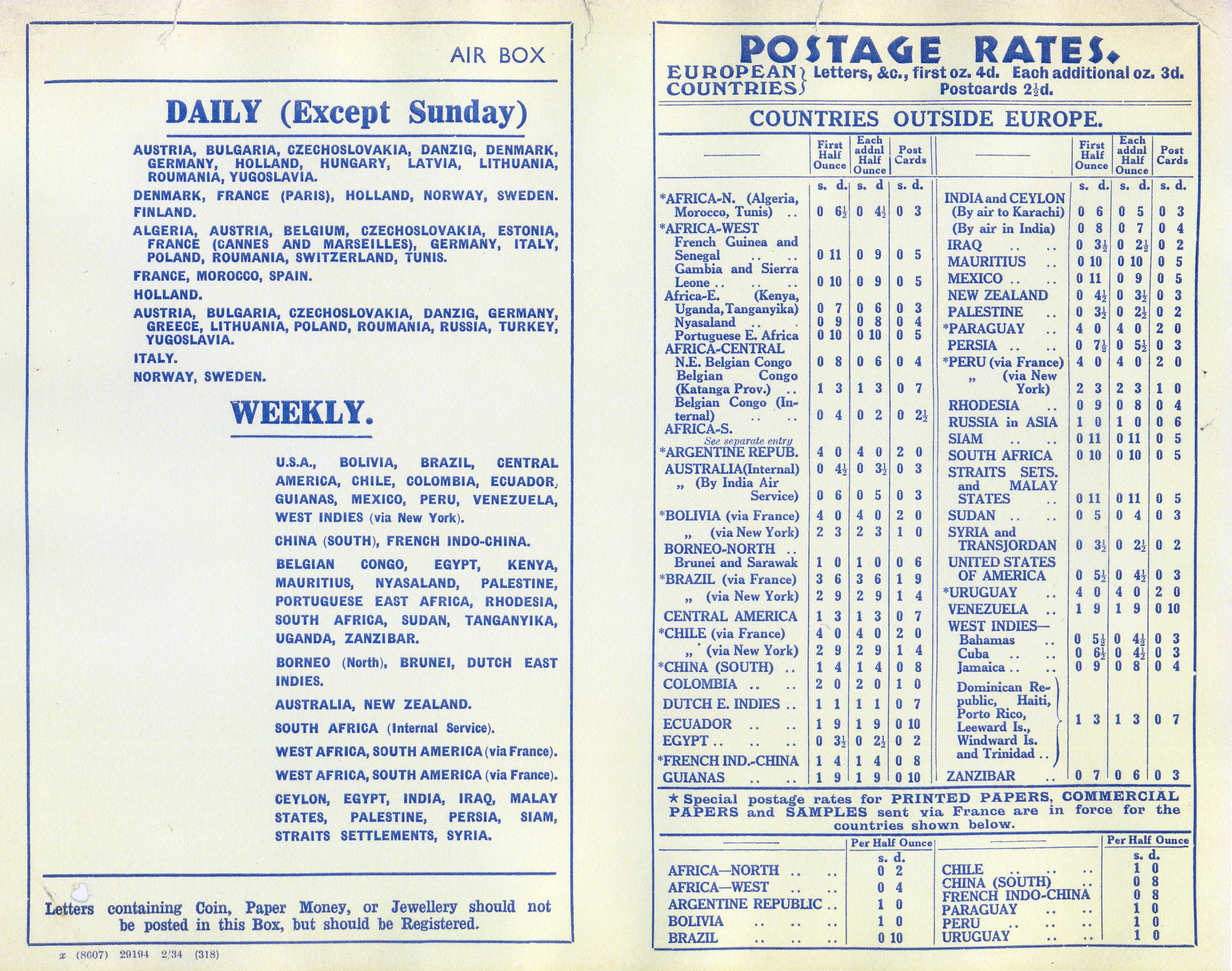
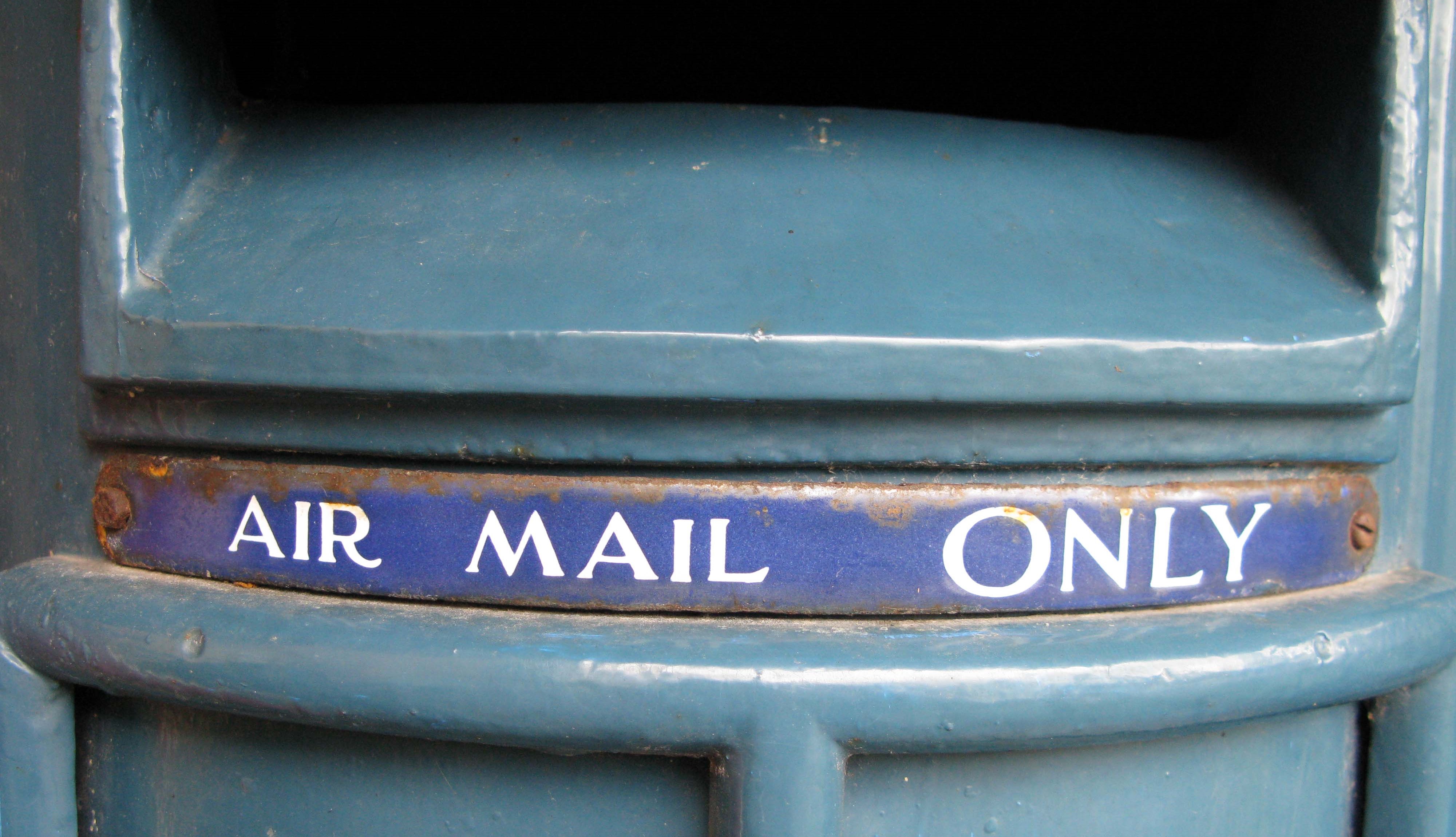
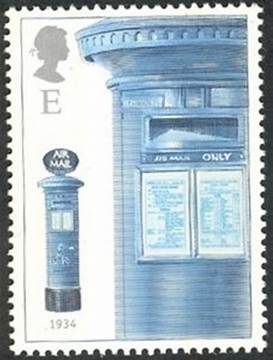

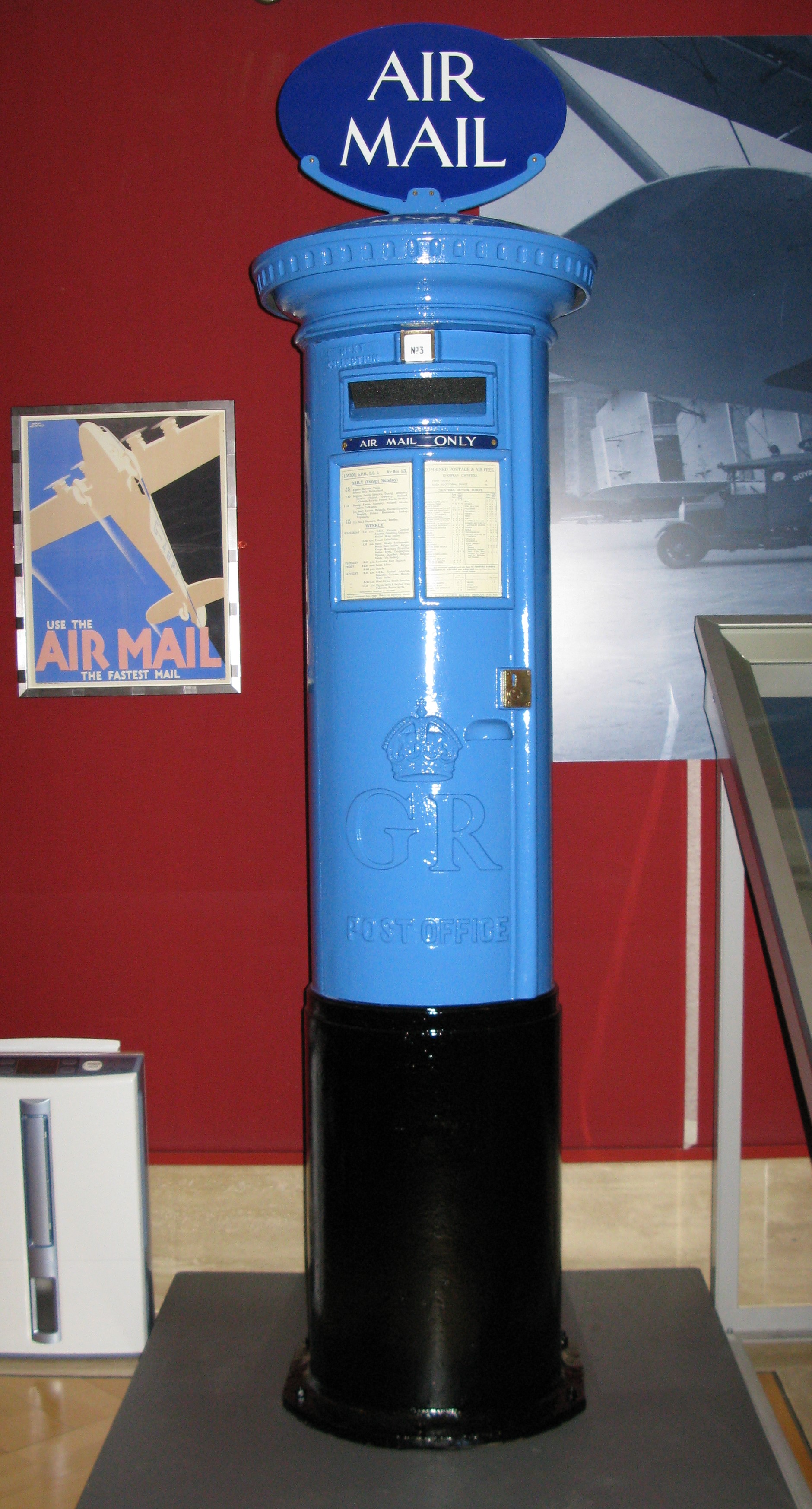
Very interesting. I feel sure I’ve seen a post box with a broken crescent shaped support on top, but I suppose this is most likely to have been holding a “This way to the PO” sign.
I’d like to know how the air mail collected from provincial boxes was handled; was it sent up to London or were there air mail flights from regional airports (I suppose airfields would be a more accurate term at the time) too?
LikeLike
Hi Daniel. Yep, your ‘crescent shaped support’ will definitely have been from a Post Office Direction (POD) sign, originally with the words POST OFFICE above and below an arrow. All the oval AIR MAIL signs would have been removed from pillar box caps when the boxes were removed and prior to repainting.
Few more northerly mails etc would have gone from their local airports, as at that time, remarkably, almost all mails went through London. Croydon was effectively, London’s airport at the time. There was an incredibly efficient national rail service operating at the time for mails- these were the Travelling Post Offices and Mail Trains.
Commercial airports were still in their infancy at the time as boundaries of overseas flight continued to be pushed, but much of the groundwork had been lain in the First World War. All those trained post-war pilots looking for a commercial outlet for their skills combined with an explosion in aircraft construction and development.
An airport was/is effectively an aerodrome with additional commercial air transport (or military). The term airport itself has much of its roots in the worlds first, at Southampton, where Seaplanes/Flying Boats took off (from 1919), taking it’s name from seaport
LikeLike